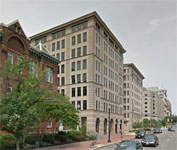How DC once fit 800,000 residents

Photo by Jesse Means on Flickr.
Over 800,000 people lived within the boundaries of the District of Columbia back in 1950. How did all of these people fit, with fewer and smaller buildings than today?
The 1951 sci-fi classic “The Day the Earth Stood Still” inadvertently shows us how. Klaatu, a level-headed extra-terrestrial emissary, escapes captivity at Walter Reed Army Medical Center. He wanders down Georgia Avenue, away from not-yet-nuclear-weapon-free Takoma Park, and attempts to disappear into everyday DC.
To do so, Klaatu checks into a boarding house at 14th and Harvard in Columbia Heights. Each room houses one or two people, and as such there’s scant privacy to be had: everyone overhears everything.
This is convenient for Klaatu, who knows little of Earthlings’ simple ways, but probably annoying for the Earthlings. Conditions like these were common in DC homes at the time.
The 1950 census found 14.1% of the District’s 224,142 occupied housing units to be “overcrowded” (with over 1 person per room). By 2011, that figure had fallen by 2/3, to 4.7%, similar to the 5.3% of homes in 1950 that were extremely overcrowded (more than 1.5 occupants per room).
This crowding meant that on average, every apartment and house in DC had one more person living inside: households were 50.2% larger! In 1950, 3.2 people occupied each dwelling unit. In 2007-2011, the number of persons per household had fallen to 2.13, so the city’s population still fell to 617,996. That decline would have been much steeper had the city not built 74,760 new housing units: the city’s population would have plunged to 477,422, and the nation’s capital would be less populous than Fresno.
Household size shrank nationwide as families changed. In 1960, married couples with children outnumbered single-person households almost three to one. In 2010, singles easily outnumbered nuclear families nationwide, and by 5.57 to one in DC.
As DC. gets reacquainted with the notion of population growth and begins to plan for a much larger population within the same boundaries, we’ll have to have a realistic conversation about household sizes and housing production. A change of just 0.09 persons per household means the difference between planning for 103,860 or 140,515 additional housing units,1 or a total of 35% to 47% more units.
That amounts to 2,000-3,000 additional units per square mile of land, after subtracting the 10.5 square miles of parks and 7 square miles of water from DC’s 68 square miles.
Klaatu, unfamiliar with our contentious Earth politics and “impatient with stupidity,” might propose to build a platform of 5-unit-per-acre suburbia above the existing city, or require every second or third home to be subdivided, or return to 1950s household sizes and require every home to take in one boarder (not necessarily extra-terrestrials). But since Klaatu is no longer with us, we will instead have to figure out more complicated ways of infilling a built-up city.
We’ve obviously figured it out before; after all, DC has added an Alexandria’s worth of housing units to its existing housing stock since 1950, plus plenty of offices, museums, hospitals, parking garages, and the like.
A lot of that change has happened around places like 1615 M Street NW, the address where a 1954 radio version of “The Day the Earth Stood Still” placed Klaatu’s boarding house. Today, 1615 M is a 9-story Class A office building that brackets the historic Magruder and Sumner schools.
The area above K but below Massachusetts was a high-density mixed residential area in the 1950s, what Park & Burgess would’ve known as “the zone in transition,” but today the height-constrained central business district has spread north to Massachusetts Avenue. Yet in fact many foreign visitors still board on that block, at the Jefferson Hotel and the University of California’s Washington Center.
Unlike in the movie, there is no way that Klaatu can make DC’s growth “Stand Still,” and so the built fabric of many other DC neighborhoods will have to change in the near future. Thankfully, neither is there a grumpy Gort (pictured above) parked on the Ellipse, who will destroy the earth with laser-beam eyes if we don’t all just get along.
A version of this article was previously posted at west north.

